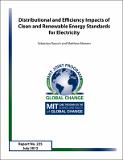| dc.contributor.author | Rausch, Sebastian | |
| dc.contributor.author | Mowers, Matthew | |
| dc.date.accessioned | 2012-07-17T18:18:54Z | |
| dc.date.available | 2012-07-17T18:18:54Z | |
| dc.date.issued | 2012-07-17 | |
| dc.identifier.uri | http://hdl.handle.net/1721.1/71656 | |
| dc.description | http://globalchange.mit.edu/research/publications/reports/all | en_US |
| dc.description.abstract | We examine the efficiency and distributional impacts of greenhouse gas policies directed toward the electricity
sector in a model that links a “top-down” general equilibrium representation of the U.S. economy
with a “bottom-up” electricity-sector dispatch and capacity expansion model. Our modeling framework
features a high spatial and temporal resolution of electricity supply and demand, including renewable
energy resources and generating technologies, while representing CO2 abatement options in non-electric
sectors as well as economy-wide interactions. We find that clean and renewable energy standards entail
substantial efficiency costs compared to an economy-wide carbon pricing policy such as a cap-and-trade
program or a carbon tax, and that these policies are regressive across the income distribution. The geographical
distribution of cost is characterized by high burdens for regions that depend on non-qualifying
generation fuels, primarily coal. Regions with abundant hydro power and wind resources, and a relatively
clean generation mix in the absence of policy, are among the least impacted. An important shortcoming
of energy standards vis-`a-vis a first-best carbon pricing policy is that no revenue is generated that can be
used to alter unintended distributional consequences. | en_US |
| dc.description.sponsorship | The authors acknowledge the support of the Joint Institute for Strategic Energy Analysis, which is
operated by the Alliance for Sustainable Energy, LLC, on behalf of the U.S. Department of
Energy’s National Renewable Energy Laboratory, the University of Colorado-Boulder, the
Colorado School of Mines, the Colorado State University, the Massachusetts Institute of
Technology, and Stanford University under grant NREL 6A502020 “Integration of a Computable
General Equilibrium Model with an Electricity Sector Optimization Model to Assess the
Economic Impacts of U.S. Climate Policy”. We further acknowledge support of the MIT Joint
Program on the Science and Policy of Global Change through a combination of government,
industry, and foundation funding, the MIT Energy Initiative, and additional support for this work
from a coalition of industrial sponsors (for a complete list see:
http://globalchange.mit.edu/sponsors/all). | en_US |
| dc.language.iso | en_US | en_US |
| dc.publisher | MIT Joint Program on the Science and Policy of Global Change | en_US |
| dc.relation.ispartofseries | Joint Program Report Series;225 | |
| dc.rights | An error occurred on the license name. | en |
| dc.rights.uri | An error occurred getting the license - uri. | en |
| dc.title | Distributional and Efficiency Impacts of Clean and Renewable Energy Standards for Electricity | en_US |
| dc.type | Technical Report | en_US |
| dc.identifier.citation | Report 225 | en_US |
